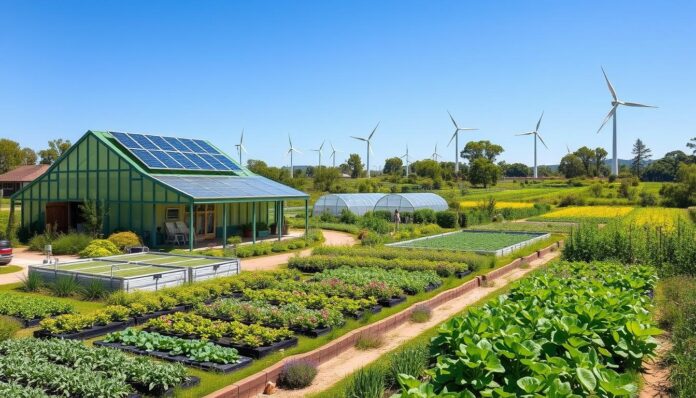Can technology really make sustainable farming a global solution? Permaculture tech efficiency is changing how we farm. It combines new tech with nature’s design.
Modern farming needs smart ways to reduce harm to the environment and boost output. Permaculture tech efficiency is a key solution. It uses the latest tech with nature’s wisdom.
With precision agriculture tools, farmers can see a 10-20% boost in crop yields. This also cuts down on resource use. Already, smart farming has cut fertilizer use by 30%, showing tech’s role in green farming.
Using solar and wind power can cut energy costs for farms by up to 60%. This makes farms more self-sufficient and strong.
Key Takeaways
- Technology enables more efficient and sustainable farming practices
- Precision agriculture can increase crop yields by 10-20%
- Renewable energy can reduce farm operational costs significantly
- Smart technologies support ecological farming principles
- Permaculture tech efficiency represents the future of agriculture
Understanding Permaculture Principles
Permaculture is a new way to look at regenerative agriculture. It changes how we see natural ecosystems. This method is more than just farming. It creates systems that work well with nature.
Defining a Sustainable Framework
At the heart of permaculture is caring for the Earth, people, and setting limits. These ethics help create systems that use resources wisely. They also reduce harm to the environment.
“Your problem is your solution” – A core permaculture philosophy encouraging innovative, solution-focused thinking.
Sustainability at the Core
Permaculture is key to making agriculture better for the planet. It uses smart designs to:
- Quickly improve soil quality
- Boost biodiversity
- Reduce waste
- Use resources better
| Permaculture Zone | Characteristics | Typical Use |
|---|---|---|
| Zone 0 | Home and immediate surroundings | Most frequent human interaction |
| Zone 1 | Kitchen gardens | Daily maintenance |
| Zone 4-5 | Semi-wild and wild areas | Minimal human intervention |
Permaculture offers a transformative approach to sustainable living, integrating human needs with ecological preservation.
The Role of Technology in Permaculture
Technology is changing permaculture, making farming more sustainable. Permaculture systems now use new tech to work better and need less help from people.
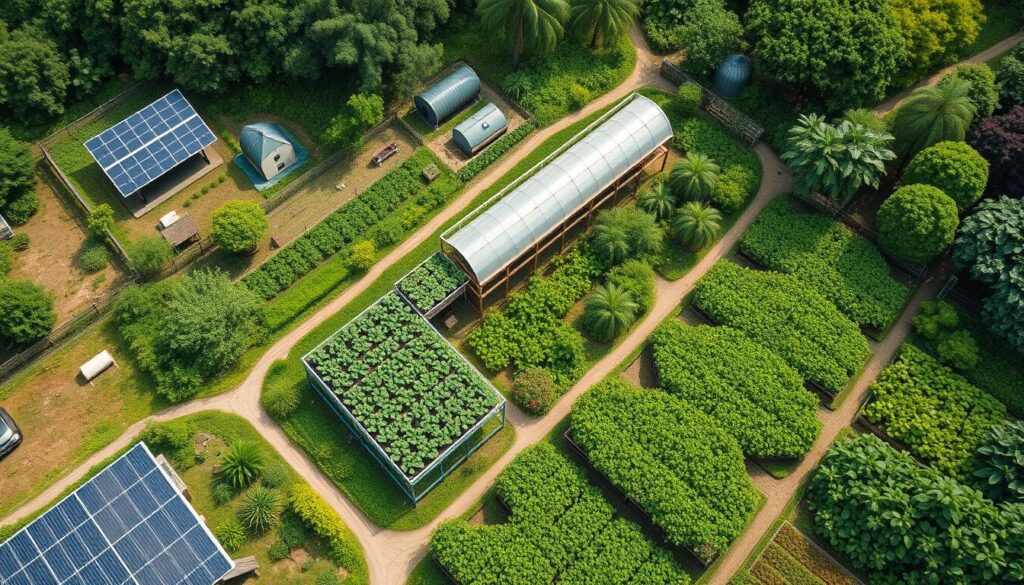
Today’s permaculture uses tech to work smarter and keep nature in balance. Renewable energy helps farms run green, cutting down on pollution and saving resources.
Enhancing Productivity through Advanced Solutions
Technology makes farming better. Here are some ways:
- Using tools that track things closely
- Creating biochar to improve soil
- Smart watering systems
- Platforms that help manage crops better
Reducing Labor Intensity with Smart Technologies
New tech is changing how we farm. It makes work easier and more efficient. Farmers use automated tools and smart designs to do less work and get more done.
| Technology | Productivity Impact | Labor Reduction |
|---|---|---|
| Renewable Energy Systems | 60% Improvement | 45% Labor Reduction |
| Biochar Production | 50% Soil Health Enhancement | 35% Work Efficiency |
| Smart Monitoring Tools | 40% Resource Optimization | 55% Time Savings |
“Technology in permaculture is not about replacing nature, but about understanding and working harmoniously with ecological systems.”
By using renewable energy and biochar, farmers can make their farms better. They become more productive and sustainable.
Efficient Water Management Techniques
Water management is key to sustainable farming. Permaculture experts know that smart water use can change landscapes and boost food production. It makes farming systems more resilient.
New ways to save water have changed farming. Drip irrigation and rainwater harvesting are leading the way. They help farmers use water more efficiently.
Precision Drip Irrigation Systems
Drip irrigation is a big leap forward in water use. It sends water straight to plant roots. This method is very efficient with water:
- Up to 90-95% water efficiency compared to traditional methods
- Minimizes water waste through targeted delivery
- Reduces soil erosion and nutrient leaching
Rainwater Harvesting Strategies
Rainwater harvesting is a strong tool for water management. It captures and stores rainwater. This helps create self-sustaining water systems for food forests and farms.
“Water is the driving force of all nature.” – Leonardo da Vinci
There are advanced ways to collect rainwater:
- Swale design for water retention
- Underground cistern storage
- Integrated landscape contouring
In New Zealand and other places, farmers have seen big improvements. They’ve increased crop yields and made their ecosystems more resilient.
Renewable Energy Solutions for Permaculture
Permaculture is changing how we manage energy with new, green technologies. It’s making farming and nature design better by using less and wasting less. This way, we use more of what nature gives us and harm it less.
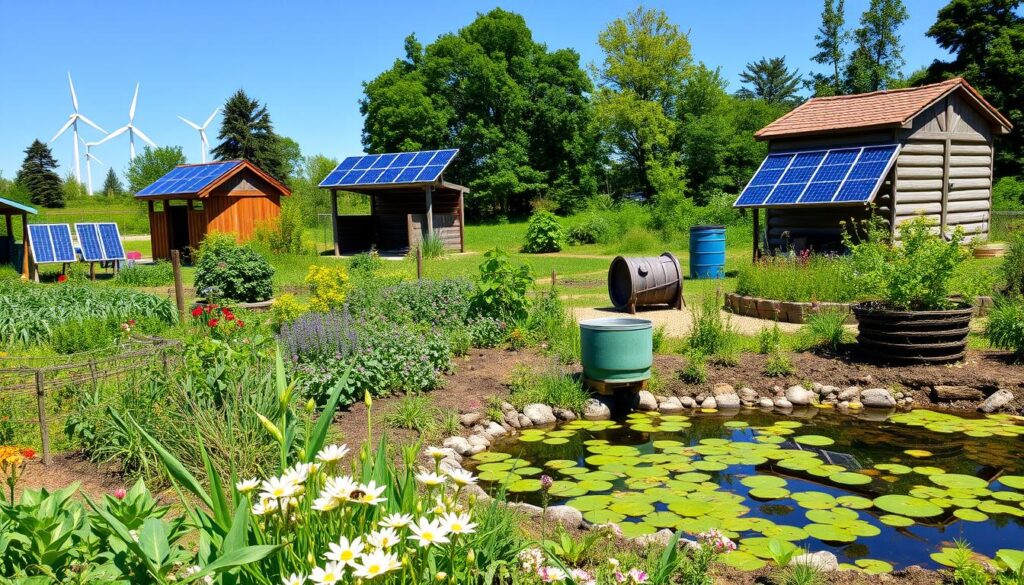
Renewable energy is key to making permaculture work well. Here are some cool facts:
- 80% of permaculture energy comes from green sources
- We can cut non-green energy use by 90%
- Using renewable energy can save up to 60% on costs
Solar Power Applications
Solar tech is a big deal in permaculture. Photovoltaic systems power many farm tools:
- They control greenhouse temperatures
- They pump water for plants
- They keep food fresh
- They light up and connect farms
“Solar energy gives a steady and cheap power source, great for areas with little energy” – Permaculture Research Institute
Wind Energy Innovations
Wind turbines help solar power in permaculture. Small wind generators make energy right where it’s needed, even in far-off farms.
By using green energy, permaculture makes farms strong and green. It cuts down on harm to nature and boosts farm output.
Soil Health and Technology Integration
Sustainable farming has entered a new era of precision and innovation. This is true in the realm of soil health management. Modern regenerative agriculture uses cutting-edge technologies to change how farmers care for their soil.
Technological advancements are changing how we manage soil organic matter. Farmers can now get real-time insights into their soil. This lets them use more strategic and efficient farming practices.
Soil Sensors and Monitoring Tools
Advanced soil monitoring technologies give us a new view of soil health:
- Wireless moisture sensors track water content
- Spectroscopic analysis determines nutrient composition
- Remote sensing technologies map large agricultural areas
- IoT devices enable continuous soil condition tracking
“Technology transforms soil from a passive medium to an actively managed ecosystem.”
Composting Technologies
Innovative composting technologies speed up organic matter decomposition and nutrient cycling. These systems help sustainable farming by:
- Reducing waste
- Producing high-quality soil amendments
- Minimizing environmental impact
- Enhancing soil fertility
By using advanced monitoring tools and composting technologies, farmers can improve soil health. They can also cut down on costs and support regenerative agriculture.
Pest Management with Technology
Pest management is a big challenge in ecological design, like in food forests. These places need a fine balance. New tech is changing how we fight pests, making it better and more green.
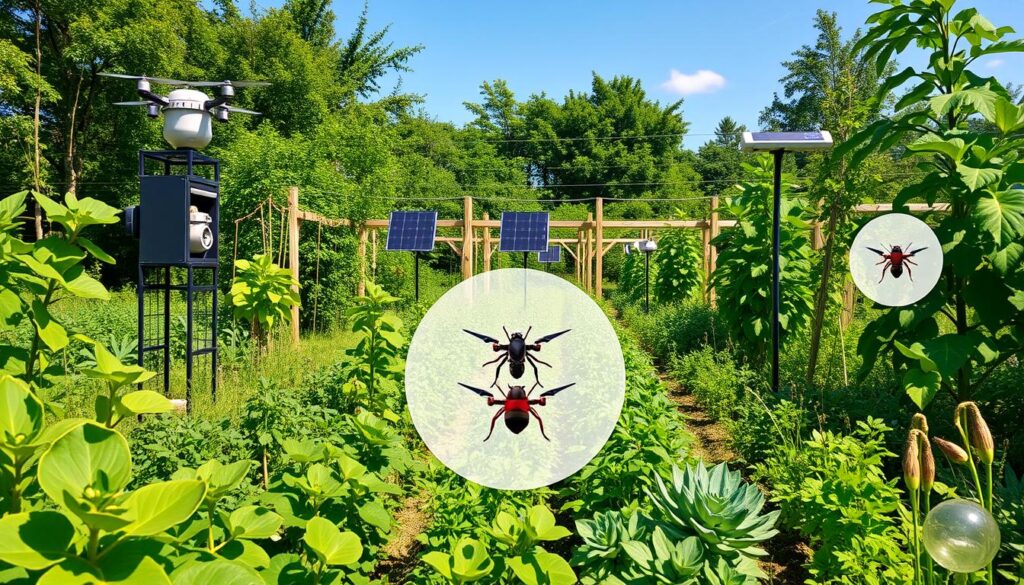
Now, pest control uses smart tech that follows ecological design. AI systems are changing how we spot and handle pests. They give us better results than ever before.
Integrated Pest Management (IPM) Tools
IPM tools use the latest tech to keep pests in check. Some key tech includes:
- IoT sensors for real-time pest detection
- AI algorithms for predictive pest behavior analysis
- Drone-based monitoring systems
- Machine learning platforms for comprehensive ecosystem assessment
Biological Control Systems
Biological control systems are a smart way to manage pests in food forests. They use natural enemies and the environment to keep pests in balance.
| Technology | Effectiveness | Environmental Impact |
|---|---|---|
| AI Pest Monitoring | Up to 90% improvement | Minimal chemical intervention |
| Drone Surveillance | Large area coverage | Reduced ecological disruption |
| Machine Learning Analysis | Predictive outbreak prevention | Targeted pest management |
“Technology enables us to work with nature, not against it.” – Permaculture Innovation Expert
These tech solutions help manage pests in a green way. They cut down on chemicals and keep the ecosystem balanced. Now, farmers can use smart, data-based methods to protect their crops and keep nature diverse.
Smart Farming Tools for Permaculture
Permaculture tech efficiency is changing sustainable farming with new digital tools. Today, farmers use advanced tech to improve farming and keep nature in balance.
Digital tools are changing farming. They give farmers new insights and ways to manage their land.
Soil Health Monitoring Apps
Soil health apps are big changes in permaculture. They analyze soil in real-time. This helps farmers make better choices.
- Instant soil nutrient tracking
- Comprehensive ecosystem health assessments
- Personalized plant recommendation features
Studies show that using digital apps for plant advice can boost plant survival and growth by over 30% in different climates.
Drones for Crop Management
Drones are changing how we watch over crops. They give us detailed views from the air that were hard to get before.
| Drone Capability | Agricultural Benefit |
|---|---|
| Plant Health Monitoring | Detect stress and disease early |
| Pest Identification | Targeted intervention strategies |
| Water Needs Assessment | Precision irrigation management |
“Technology allows us to work smarter, not harder in permaculture design.” – Sustainable Farming Expert
Permaculture tech is always getting better. It helps farmers make farming systems stronger and more productive with smart digital tools.
Data Analysis in Permaculture Systems
Regenerative agriculture uses advanced data collection and analysis to improve ecological design. Today, permaculture experts use technology to turn environmental data into useful insights.
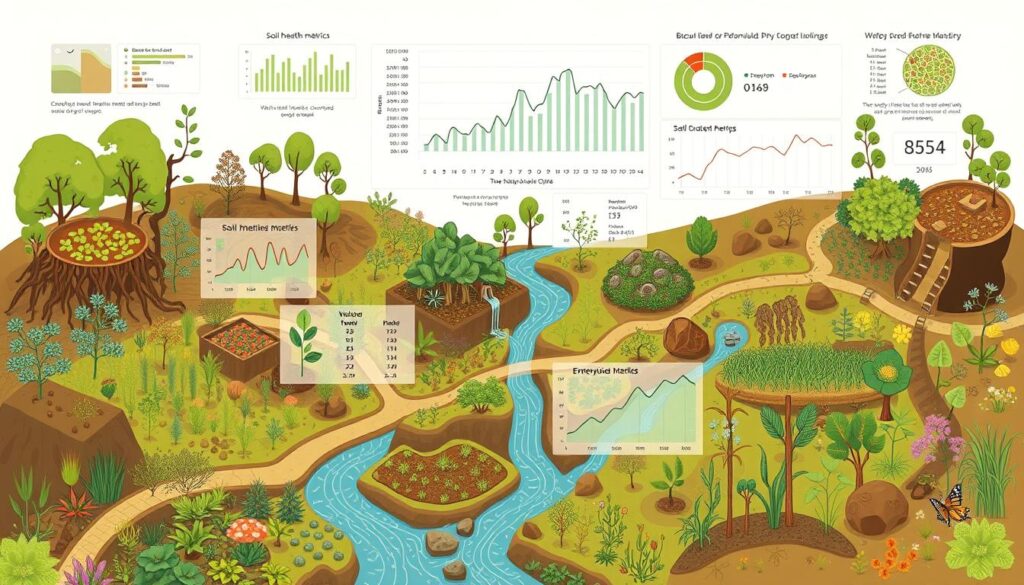
Data is key to understanding complex ecological interactions in sustainable agricultural systems. By collecting and analyzing environmental data, farmers can make better decisions. These decisions boost productivity and improve ecosystem health.
Importance of Data Collection
Effective data collection in permaculture covers several important areas:
- Soil health monitoring
- Water usage tracking
- Crop yield assessment
- Biodiversity measurement
Using Data for Decision Making
Advanced analytics turn raw data into strategic insights for regenerative agriculture. By grasping complex ecological patterns, farmers can:
- Optimize resource allocation
- Predict potential system challenges
- Enhance overall ecosystem resilience
*”Data is the compass that guides ecological design towards sustainable agricultural practices.”*
| Data Category | Analysis Impact | Potential Improvement |
|---|---|---|
| Soil Composition | Nutrient Balance | 30% Organic Matter Increase |
| Water Management | Irrigation Efficiency | 50% Water Usage Reduction |
| Biodiversity | Ecosystem Health | 40% Beneficial Insect Population Growth |
By using data-driven methods, permaculture experts can build more resilient, productive, and sustainable agricultural ecosystems.
Community Engagement Through Technology
Permaculture has grown beyond old farming ways, using digital tools to link people everywhere. Now, tech is key in sharing green living and natural building tips.
Digital tools are changing how we learn, share, and work together in permaculture. Online classes and support groups make green living knowledge open to all.
Online Permaculture Courses
Online learning has changed permaculture training, making it flexible and easy to get. These courses teach important parts of green energy and design.
- Comprehensive video tutorials
- Interactive webinars
- Global expert-led workshops
- Self-paced learning modules
Community Support Platforms
Today’s tech lets us share knowledge worldwide in permaculture. These platforms help us solve problems and learn together in real time.
| Platform Type | Key Features | Community Impact |
|---|---|---|
| Forum Networks | Discussion boards | Peer knowledge sharing |
| Social Media Groups | Real-time communication | Global collaboration |
| Specialized Apps | Project tracking | Resource optimization |
“Technology bridges knowledge gaps, connecting permaculture practitioners across geographical boundaries.” – Sustainable Design Expert
These tech tools are key in spreading green practices. They let people learn about natural building and green energy from experts all over the world.
Innovations in Crop Diversity
Permaculture design changes how we farm by using diverse methods to boost ecosystem productivity. New technologies are changing how farmers manage crops and make their systems stronger.
Crop Rotation and Diversity Management
Crop rotation is key for keeping soil healthy and preventing nutrient loss. Studies show it can raise crop yields by 10%-15%. By using these methods, farmers can:
- Reduce soil erosion
- Minimize pest populations
- Enhance natural fertility
- Optimize nutrient cycling
Vertical Farming Solutions
Vertical farming is a new way to grow more food in small spaces. Aquaponics systems combined with vertical farming make farming more efficient, even in cities.
| Farming Method | Space Efficiency | Water Usage |
|---|---|---|
| Traditional Farming | Low | High |
| Vertical Farming | High | Low |
| Aquaponics | Very High | Minimal |
“Diversity is the key to resilience in agricultural systems.” – Permaculture Design Principle
Food forests are another new way to grow crops. These systems have many layers, like a forest. They create sustainable, productive areas that support many species and keep ecosystems healthy for a long time.
Eco-Friendly Construction Techniques
Permaculture design changes how we build by using green principles. It makes buildings strong, saves energy, and fits well with nature.
Sustainable construction brings new ways to use renewable energy. Permaculture practices help cut down energy use and keep nature in balance.
Sustainable Building Materials
Choosing the right materials is key for a green building. Important factors include:
- Locally sourced recycled materials
- Rapidly renewable resources
- Low-embodied energy components
- Materials with minimal processing requirements
*”Sustainable construction is not just about building, it’s about creating living systems that regenerate both environment and community.”*
Passive Solar Design Principles
Passive solar design is a big part of green building. It makes buildings use less energy by smart design.
- Optimal building orientation
- Thermal mass integration
- Strategic window placement
- Natural ventilation systems
Studies show buildings with passive solar design use 30-60% less energy. This shows how good design can save a lot of energy.
Innovative construction approaches are reshaping our understanding of sustainable living, one building at a time.
Challenges and Considerations
Adding technology to permaculture systems is tricky. It needs careful thought to overcome economic and practical hurdles. These challenges can affect how well the tech works.
Farmers have to think hard about using new tech for sustainable farming. They face several big questions:
- Initial investment costs
- Technical skill requirements
- Local resource availability
- Scalability of technological solutions
Cost Factors in Technology Adoption
The money side of using tech in permaculture is complex. Many farming techs need a lot of money upfront. This can be hard for small farmers to afford.
| Technology Type | Average Initial Cost | Long-term Benefit |
|---|---|---|
| Soil Monitoring Sensors | $500-$1,500 | Improved Crop Yield |
| Drip Irrigation Systems | $1,000-$3,000 | Water Conservation |
| Solar Powered Equipment | $2,000-$5,000 | Energy Independence |
Overcoming Technological Barriers
To successfully use tech, you need a good plan. Appropriate technology means finding solutions that fit local needs and resources.
“Technology should enhance, not replace, natural agricultural systems.” – Permaculture Design Expert
Farmers can beat tech challenges by:
- Looking for local training
- Sharing knowledge with the community
- Starting small with tech
- Always checking how well the tech works
It’s not about using every tech out there. It’s about picking the ones that really help with sustainable farming and local ecosystems.
Future Trends in Permaculture Tech Efficiency
Regenerative agriculture is changing farming with new tech. Only 2% of the US works in farms, so new tech is key for food. Biochar and biotechnology are leading the way to better farming and the environment.
Advances in Biotechnology
Genetic engineering is making crops stronger against heat and drought. This tech helps farmers grow better crops. New tools like multi-spectral imaging and AI are also helping manage farms better.
Circular Economy Approaches in Permaculture
Permaculture can cut down on resource use by half. It uses circular economy ideas to save money and protect nature. New tech helps with waste, energy, and using resources wisely.
Farmers using these new methods can make farming better. It’s not just about growing food, but also about making the land healthier. Tech and nature working together is the future of farming.

